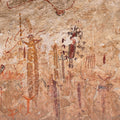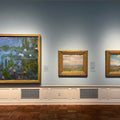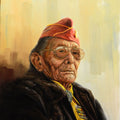Highlights of the Eiteljorg Museum's Western Art galleries
By Medicine Man Gallery on

Thomas Hart Benton, Lewis and Clark at Eagle Creek, 1967. Collection of the Eiteljorg Museum | Photo by Chadd Scott
The first friendly face I see upon entering the Eiteljorg Museum in Indianapolis is Bill Pickett’s. Bernard Williams’ Black Cowboy – Bill Pickett painting to be more precise. The five-foot portrait of a smiling Pickett placed just inside the entrance to the Eiteljorg’s Art of the American West ground floor permanent collection gallery greets all visitors.
I made my third trip to the Eiteljorg in September of 2023 and Pickett draws me in every time. In the art world, this painting has what is called “wall power.” You can’t ignore it. The size, the subject, the color – it has presence.
Painted expressively with a thick, rough impasto, Black Cowboy – Bill Pickett contrasts starkly with the next artwork I continually find myself attracted to, Thomas Hart Benton’s Lewis and Clark at Eagle Creek. I’m a sucker for a western landscape and this one is as fine as you’ll find anywhere.
It’s polymer and tempera on board, not oil, so the surface is slick, and the lines are precise, all composed in Benton’s signature curvy, swoopy fashion. His colors are simultaneously rich and soft – a purple mountains majesty in the background stands out.
Regarding this picture, and Pickett, it occurs to me how I have changed since my first time at the Eiteljorg in 2019. How my interests have changed. How my awareness has changed. Back then, Black Cowboy – Bill Pickett intrigued me because of its visual qualities more than the storytelling around Black cowboys and their erasure from histories of the West.
Likewise, Lewis and Clark at Eagle Creek previously struck me primarily for its visual brilliance. Not anymore. This time, I found the painting disturbing, the gorgeous paint unable to hide the history inspiring it.
I have come to see Lewis and Clark as the tip of the spear for American colonialism in the West. Forebearers of the evils of Manifest Destiny.

Daniel Smith, Stillwater Crossing, 2009. Collection of the Eiteljorg Museum. | Photo by Chadd Scott
Within 100 years of their Voyage of Discovery, America would go to war with the Western tribes, commit genocide against the Western tribes, make and break countless treaties with the Western tribes, slaughter the buffalo near to extinction to starve the Western tribes – there are buffalo in the foreground of Benton’s painting – establish the horrific Indian Board School program and commit countless other outrages on the continent’s Indigenous population.
That’s what I see when looking at the painting now; I no longer see explorers or heroes or anything to be proud of.
Next to the Benton is a painting newly installed since my last visit in 2021, Page Allen’s wonderfully spare North featuring a pair of pronghorn framed by mountains facing each other with a road bisecting the scene.
From anywhere on this side of the gallery, it’s impossible to overlook Wilson Hurley’s monumental, wall-spanning tryptic October Suite, Grand Canyon. A person could lose themselves for hours in its minute details. A much smaller painting catches my eye, however, in a way it didn’t previously. That would be Georgia O’Keeffe’s Taos Pueblo.
I hadn’t been to Taos Pueblo when I last visited the Eiteljorg, but I have since, and this artwork now appeals to me in a way it didn’t previously. I’m struck by how similar Taos Pueblo continues to look from the way O’Keeffe saw it 100 years ago.
From there, the presentation shifts to the Taos Society of Artists.
I love the detail of a Native American batter and catcher at home plate in Oscar Berninghaus’ Baseball Game, Taos from 1930. Too bad sports weren’t the only thing white culture brought to the West.
The major TSA artists are represented, as are their contemporaries and successors. Walter Ufer’s Taos Summer Landscape is a joyous celebration of fall in yellow and blue.

Theodore Van Soelen, Shadows, undated. Collection of the Eiteljorg Museum | Photo by Chadd Scott
Theodore van Soelen’s Shadows may be my favorite painting in the entire museum. His depiction of an adobe home bathed in sunlight and shadow against the mountains of northern New Mexico with a light covering of snow on the ground is at the same time warm and cold. It’s a remarkable trick.
Next to Shadows, separating the gallery entrance from the TSA paintings while allowing for a sightline between them, is Doug Hyde’s (Nez Perce/Assiniboine/Chippewa) brilliant Salmon Quest sculpture. Delicately carved from pink Portuguese marble, it depicts a salmon breaking free from cresting waves. The piece was acquired through the Eiteljorg’s Purchase Award as part of its annual “Quest for the West” art show and sale, the museum’s signature annual event. Numerous artworks in the galleries share a similar provenance.
From the TSA paintings, guests are led into the Gund Gallery of Western Art where portrayals of Native Americans in Western art are highlighted along with works from many of the genre’s “founding fathers” including Albert Bierstadt, Thomas Moran, Maynard Dixon and a large number of items from Fredric Remington and C.M. Russell.
Continuing on, Dean Cornwall’s Americanization of California (1927–1932) mural stands out. While beautifully composed, an in-depth video display in front of the painting does a wonderful job of highlighting its numerous problems. Start with the headdress the prominent Native American figure wears. No Indigenous person to California would have ever worn such a garment. The depiction is an “Indian” trope of Plains Indians.
At least there are Native people shown. There are no people of African or Asian descent pictured, despite their essential contributions to the “Americanization of California.”
Every time I visit the Eiteljorg, it seems the museum has done more to call attention to overlooked stories across the West such as these. Adjacent to Cornwall’s mural in a position impossible to miss hangs Jishiro Miyauchi’s Heart Mountain, Wyoming depicting the World War II era Japanese American concentration camp located there. This painting was not on view the last time I visited and is a welcome and bracing reminder of history in the West beyond its romance. Miyauchi was imprisoned at Heart Mountain.
I leave the gallery, as always, saying “goodbye” to Daniel Smith’s remarkable, photorealistic buffalo painting Stillwater Crossing, another “Quest for the West” acquisition – my brother and nephew’s favorite picture.
These are my favorite artworks at the Eiteljorg Museum, I can’t recommend highly enough visiting for yourself to find your own.

Bernard Williams, Black Cowboy-Bill Pickett, 1995. Collection of the Eiteljorg Museum | Photo by Chadd Scott



